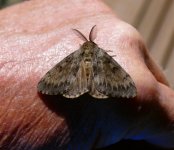KenM
Well-known member
A good night for me last night, although nothing like the scale of thread 19...an excellent haul by anybody's standards! (fingers x'd that I might get another one this year).
Circa 20 plus species to include Iron and Coxcomb Prominents, 5 Brimstones, (5 Hornets all moribund this am)+ 2 Lifers...Pyrausta aurata and Gypsy Moth
Cheers
Circa 20 plus species to include Iron and Coxcomb Prominents, 5 Brimstones, (5 Hornets all moribund this am)+ 2 Lifers...Pyrausta aurata and Gypsy Moth
Cheers






